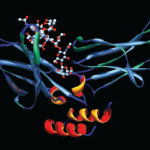WASHINGTON, D.C.–Despite all the worry that tumor necrosis factor (TNF) inhibitors might heighten the cancer risk in arthritis patients, the evidence is fairly scant that there is a big risk, the co-editor of the ACR’s Drug Safety Quarterly said in a session titled, “Update on Safety Issues in the Treatment of Rheumatic Diseases,” here at the 2012 ACR/ARHP Annual Meeting, held November 9–14. [Editor’s Note: This session was recorded and is available via ACR SessionSelect.]
Overall, “there is no drug-related risk of new cancer, and there appears to be no added risk of cancer recurrence in several short-term studies,” said John Cush, MD, who is also director of clinical rheumatology at the Baylor Research Institute in Dallas, during a session on safety issues related to rheumatology therapies.
The topic drew great interest in 2003, when a U.S. Food and Drug Administration (FDA) evaluation of three TNF inhibitors—etanercept, infliximab, and adalimumab—and the treatment of 6,303 patients found that six people taking TNF blockers developed lymphoma, while none on placebo did. In a postmarketing review, another 165 lymphomas were discovered from the nearly 515,000 patients taking TNF inhibitors since their release.
The FDA—which eventually required a black-box warning about cancer risk— found that the standardized incidence ratio was 3.47 for etanercept, 6.4 for infliximab, and 4.35 for adalimumab.
But those numbers are “overlapping what’s seen in RA [rheumatoid arthritis] risk,” Dr. Cush said. “Patients with uncontrolled inflammation have a two- to tenfold risk of lymphoma and maybe as high as a 71-fold risk in those with the most active disease.”
Meta-analyses—involving 20,000 to 70,000 patients—have yielded similar findings, he said.
The story is similar in the recurrence of cancer in RA patients who’ve had cancer previously—there’s not much data indicating a heightened risk for recurrence.
Examining Other Types of Cancer, Specific Populations
The risk, though, doesn’t appear to be the same with all kinds of cancer, Dr. Cush said.
A 2010 study looking at 293 patients with prior malignancies found that there was a higher incidence of melanoma recurrence among patients taking TNF blocker than patients taking disease-modifying anti-rheumatic drugs (DMARDs)—3 out of 17 patients with prior melanoma had a recurrence, compared to 0 out of 10 in the DMARD group.1
“While overall cancers were less on the TNF inhibitor, they were more if you had an issue with melanoma,” Dr. Cush said. “Maybe you should be exercising caution in patients with a prior history of melanoma.”
Cancer incidence among children with juvenile idiopathic arthritis (JIA) has also been raised as a concern by the FDA. But there is also debate over this point—and increased cancer risk might be caused by the disease rather than the drug, Dr. Cush suggested.
“What we don’t know here, and what’s been a problem in this literature, has been what is the background rate of lymphoma and cancer in children,” he said. “There are some studies that say there is no increase in children. The more recent studies, and I think the weight of the evidence, suggest that JIA behaves just like RA, and that inflammation drives risk of cancer.”
When asked about the black-box warning and told by an audience member that, patients with cancer will not want to take an anti-TNF drug despite little evidence that the risk is real, Dr. Cush said, “I’m not aware of black-box warnings that go away very easily or very quickly … A lot has happened in the last 10 years. You can either focus on the black box, or focus on the research.”
Discussing Tofacitinib
Larissa Lapteva, MD, clinical team leader from the FDA’s Division of Pulmonary, Allergy, and Rheumatology Products, gave an overview of the effectiveness and safety of the janus kinase inhibitor tofacitinib (Xeljanz), approved in November as the first new oral DMARD in more than a decade.
Although the drug showed effectiveness in reducing disease activity, its effects on radiographic progression were less clear. According to the manufacturer’s data, the effect was statistically significant in this regard, but when the FDA performed several sensitivity analyses including removal of an outlier from the calculation, the results fell short of significance.
“There is a high proportion of nonprogressors in the placebo arm, which makes it difficult to demonstrate the difference between the treatment groups, and that’s one inherent limitation of this study,” Dr. Lapteva said. She added that, “the product may have some effect on radiographic progression; however, based on the current data, uncertainty still remains with this conclusion.”
Safety data show there were seven lymphoproliferative disorders in the drug development program’s tofacitinib groups, while there were none in the placebo groups—a finding that dovetails with concerns of lymphoma occurrences seen in nonclinical studies with monkeys and in the drug’s renal allograft program.
“While this evidence does not prove the attribution of increased risk of lymphoma with tofacitinib exposure, it once again points to the immunosuppressive effects of this drug.”
The exposure-adjusted incidence rates of solid and hematologic malignancies were numerically higher in tofacitinib’s 10-mg groups compared to the 5-mg groups, while no malignancies occurred in the placebo groups in Phase III trials.
Infection rates were also higher among subjects taking tofacitinib compared with those on placebo. Dr. Lapteva also noted 12 cases of tuberculosis (TB) in the clinical development program. Six of these cases were observed in the randomized Phase III trials, and all six occurred in the 10-mg groups.
Changes in hematological parameters, liver function tests, and lipids were observed in patients treated with tofacitinib.
To monitor for safety, patients should be evaluated and tested for TB before they’re given the drug and monitored for signs and symptoms throughout treatment. Also, blood counts should be taken at baseline, at four to eight weeks, then every three months. Routine monitoring of liver enzymes should be done, and lipid parameters should be checked every four to eight weeks.
These recommendations are included in the prescribing information for tofacitinib.
Although they provide the general basis for the product’s safe use, she said, “We all need to decide on the best approach to therapy for each individual patient, taking into consideration their disease activity and comorbid conditions.”
Thomas Collins is a freelance medical journalist based in Florida.
Reference

